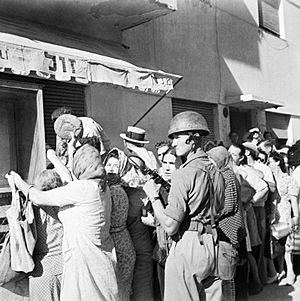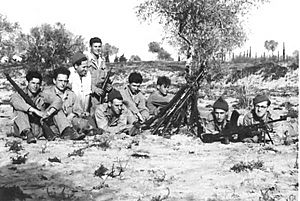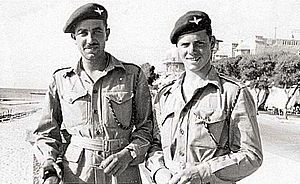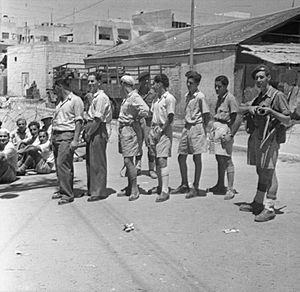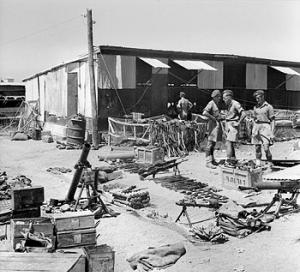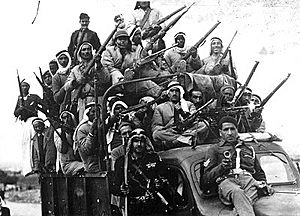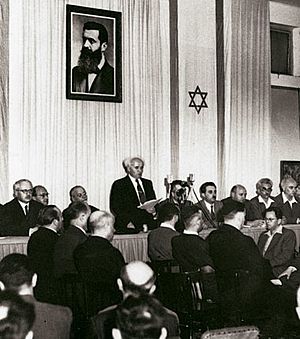6th Airborne Division in Palestine facts for kids
The 6th Airborne Division in Palestine was a special group of British soldiers. They were sent to Palestine after World War II to help keep the peace. Their main job was to be a quick-response team for the British Empire. However, they ended up dealing with security problems in the region between 1945 and 1948.
Palestine was under British control, called a British Mandate, after World War I. Great Britain was in charge of running the country and keeping it safe. The British had promised to help create a Jewish homeland in Palestine. Between 1922 and 1939, over 250,000 Jewish people moved there. But Arab groups resisted this, and World War II also caused Britain to limit immigration. During this time, Jewish resistance groups also grew and began to clash with the British.
When the British 6th Airborne Division arrived, violence was increasing. They became involved in keeping order. Their tasks included searching areas, guarding important places, and protecting convoys. As things got worse, the soldiers had to patrol cities, enforce curfews, and handle riots. They also protected Jewish and Arab towns from fighting between groups. Some soldiers from the division were killed or hurt during this time.
The British control of Palestine ended as the British Army was shrinking after the war. The number of soldiers in the division slowly went down. By the time they left Palestine, the division was much smaller. It was officially ended soon after leaving Palestine in 1948.
Contents
Why the 6th Airborne Division Was There
In July 1922, the British Mandate of Palestine was set up. This meant Great Britain was responsible for the country's government and defense. They also had to help create a Jewish homeland there. In September 1922, it was decided that this Jewish homeland would not include the land east of the River Jordan. That land became a separate country called the Hashemite Kingdom of Jordan.
The British encouraged Jewish people to move to Palestine. Between 1919 and 1939, 265,000 Jewish immigrants, mostly from Europe, settled there. Arab groups resisted this large number of new arrivals. This resistance led to violence, especially between 1936 and 1939. In 1937, a group called the Peel Commission suggested dividing the country into two states: one Arab and one Jewish. Then, in May 1939, the British limited Jewish immigration to 75,000 people in a document called the White Paper of 1939.
By the end of 1945, Jewish immigration was close to the 75,000 limit. Arab concerns led Britain to put even more limits on immigration. Even after the terrible details of the Holocaust became known, Britain's policy stayed the same. This caused serious problems between the British, Jewish immigrants, and Jewish groups who wanted a Jewish state. Many Jewish people felt the British were being unfair, like Nazi Germany. However, between 1945 and 1948, another 85,000 Jewish immigrants, many of them Holocaust survivors, entered Palestine without permission.
Jewish Resistance Groups
During this time, the Jewish Resistance Movement was formed. It included several Jewish groups that already existed. In 1921, a part-time group called the Haganah was created. It trained like a national army. Most Jewish men and some women were asked to join. After World War II, they got many extra weapons for their members. The Haganah focused on helping more Jewish people enter the country from Europe. They often tried to warn British security forces before an attack so they could leave the area.
During World War II, when Axis forces threatened the Middle East, the Haganah created a full-time, elite force called the Palmach. By 1947, this group had about 2,200 members. Palmach members followed military rules. Many had served in the British army during the war.
In 1937, some people who disagreed with the Haganah's methods formed a new group. This group was called the National Military Organization in the Land of Israel, or Irgun for short. They started a campaign of violence against the government in 1944, carrying out several attacks. By 1945, the Irgun had about 1,500 members. A third group was the Lehi, also known as the Stern Gang by the British press. Lehi had only about fifty members. It was the only Jewish group that thought about working with the Germans during the war. Later, they killed British officials. By 1946, both the Irgun and Lehi had declared war on Great Britain.
British 6th Airborne Division
The 6th Airborne Division was one of only two airborne divisions the British Army created during World War II. Before coming to Palestine, the division had only fought in Europe. They took part in the Normandy landings in June 1944 and the Battle of the Bulge in December. After crossing the Rhine River in March 1945, they spent six weeks moving across Germany to the Baltic Sea.
At the end of the war in Europe, the division was supposed to go to Burma. There, it would join another airborne division. However, the atomic bombings of Hiroshima and Nagasaki ended the war with Japan. This changed British plans. The 6th Airborne Division was chosen to be the Imperial Strategic Reserve. This meant they would be based in the Middle East as a quick-response peacekeeping force for the British Empire.
By September 1945, the division was on its way to the region for airborne training. But conditions in Palestine were getting worse. By the time the division arrived, instead of training, they were sent to deal with security problems.
What the Division Did
1945: Starting Operations
The division, still led by Major General Eric Bols, began arriving in Palestine in 1945. The first group arrived on September 15. By the end of October, the division's main headquarters was set up at Bir Salim. Soldiers were sent to camps in the Gaza area to get used to the conditions.
Soon, the division was involved in operations. They enforced a night time curfew at the end of October after railway lines were damaged. On November 13, the British government said it would look into the situation of Jewish people in Europe. They also said they would talk to Arabs to make sure Jewish immigration continued.
Jewish leaders were not happy that the announcement did not go far enough. They organized a twelve-hour strike for the next day. Riots started in Tel Aviv and the Jewish part of Jerusalem. The 3rd Parachute Brigade had to patrol the streets for the next five days.
The 6th Airlanding Brigade had its first operation after two attacks on coastguard stations on November 24-25. Police dogs tracked the attackers to the villages of Rishpon and Sidna Ali. During the search, villagers threw stones at the police. Soldiers had to stop people from other villages from joining the crowds. The next day, police fought with villagers and then called the brigade to help. The soldiers used batons and tear gas to break up the crowds. Later, 900 people were arrested.
Near the end of the year, on December 26-27, the Irgun attacked police stations, railway sites, and a British Army weapons store. The 3rd Parachute Brigade again enforced a night time curfew in Tel Aviv. On December 29, they searched Ramat Gan for Irgun members. They questioned 1,500 people and arrested eighty-nine.
1946: Increased Conflicts
The first mission of 1946 was Operation Hebron on January 8. The 3rd Parachute Brigade and police searched the town of Rishon LeZion. They took fifty-five suspects into custody. Later that month, they searched the Shapira district of Tel Aviv.
On March 5, Major General James Cassels took over command of the division. The next major event was on April 2-3. Irgun units attacked railway sites. During one attack, a British patrol hit a mine, wounding three soldiers. The soldiers chased the attackers. Reinforcements arrived. The next morning, tracks of about thirty men were found. A plane spotted them, and soldiers intercepted them. After a small fight, fourteen attackers were wounded, and twenty-six were captured.
In March, the 1st Parachute Brigade joined the division. The 6th Airlanding Brigade left the division on April 13. This reduced the division's manpower by about twenty-five percent.
On April 25, the Lehi attacked a division car park in Tel Aviv. Ten soldiers from the 5th Parachute Battalion were guarding it. About thirty attackers opened fire. They threw a bomb into a guard tent. Then, twenty attackers stormed the car park. They entered guard tents, killing four unarmed soldiers and stealing weapons. Two other off-duty soldiers were killed while trying to help. In total, seven soldiers were killed.
This was the first direct attack by any group on the British Army. The army had not set up defenses against such an attack. The next day, seventy suspects were rounded up, but no evidence was found. In response, the British put a road curfew from 6 PM to 6 AM. Cafes and restaurants in Tel Aviv were closed at night. Some soldiers, angry about the attack, attacked Jewish houses in Qastina and Be'er Tuvia, injuring some people. Those involved were later punished.
Attacks on security forces increased. On June 19, all soldiers were ordered to carry weapons at all times. They also had to travel in pairs during the day and in groups of three at night. In late June, the division received orders for Operation Agatha. This operation aimed to arrest Jewish leaders suspected of being involved in violence. It was a nationwide operation involving the 6th Airborne Division, police, and other army units. They also aimed to gather information and arrest any Palmach members.
Operation Agatha began at 4:15 AM on June 29. The 2nd Parachute Brigade was in charge of Tel Aviv. The 1st Parachute Brigade covered Jewish settlements around Ma'abarot. The 3rd Parachute Brigade was responsible for areas around Givat Brenner. The operation ended on July 1. A total of 2,718 suspects were arrested. Many had no connection to resistance groups. The 6th Airborne Division alone arrested 636 people. This included 135 suspected Palmach members and ten Jewish leaders.
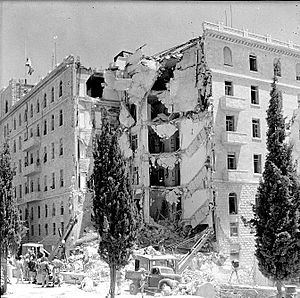
The next big event was on July 22. The British headquarters in the King David Hotel were bombed. No soldiers from the division were directly involved. However, the Royal Engineers from the 9th Airborne Squadron were called to search for survivors. They also secured the damaged building. Over three days, they found six survivors and the bodies of ninety-one victims. To help find those responsible, the 8th and 9th Parachute Battalions moved into Jerusalem on July 23.
The British responded to the bombing on July 30 with Operation Shark. They believed the bombers were hiding in Tel Aviv. Every home and building was searched for members of Lehi and Irgun. The entire city was surrounded, and a curfew was put in place. To allow people to buy food, the curfew was lifted for two hours every other day. The division's three parachute brigades each searched one-quarter of the city. The 2nd Infantry Brigade searched the last quarter. Over four days, each brigade questioned about 100,000 people. A total of 787 people were held for more questioning. During the searches, five hidden weapons stashes were found. These included machine guns, mortars, rifles, pistols, and a lot of ammunition. They also found fake money and explosives.
The division's next operations were Bream and Eel. They searched for weapons in Dorot and Ruhama. The 3rd and 8th Parachute Battalions and the 9th Airborne Squadron Royal Engineers were involved. The two villages were surrounded at dawn on August 28. Over the next six days, they searched the settlements. They found many different weapons, including heavy machine guns and mortars.
In the remaining months of the year, the division patrolled railways and roads. These were often mined. Some mines killed soldiers trying to disarm them. Orders were then given to blow up the mines instead. On December 2, a road mine killed four soldiers.
On December 13, Major General Cassels left the division. Eric Bols took command again.
1947: Moving North
Between December 29, 1946, and January 3, 1947, the division's brigades carried out seven search operations in Tel Aviv. They arrested 191 people. On January 2, several attacks were made on roads. One attack wounded eight soldiers. Another attack by Lehi on the 1st Parachute Battalion headquarters in Tel Aviv killed a Jewish policeman and wounded two soldiers. On January 18, the 6th Airborne and 1st Infantry Divisions swapped locations. The airborne division now took responsibility for the north of the country. The 2nd Parachute Brigade, though still part of the division, moved to England on January 24.
In the north, the 1st Parachute Brigade was in charge of the District of Galilee. The 3rd Parachute Brigade was responsible for the District of Haifa. The division's headquarters was at the Stella Maris Monastery. The 1st Parachute Brigade also had help from the Transjordan Frontier Force and a battalion of the Arab Legion. In the north, the division mainly protected the port of Haifa, the country's largest. They guarded oil facilities and prevented illegal immigrants from landing. On January 31, it was announced that all non-essential British civilians would be evacuated due to the worsening situation. The evacuation from Haifa took place between February 5 and 8, controlled by the 8th Parachute Battalion and the Royal Navy.
On May 4, about forty men carried out the Acre Prison break. They freed forty-one Jewish and 214 Arab prisoners. At the same time, a mortar attack was launched on the 2nd Parachute Battalion's camp as a distraction. The first British unit to reach the prison was a small group from the 1st Parachute Battalion, 35 minutes later. Other soldiers were bathing nearby. A truck full of escaping prisoners opened fire on a British armored car. The truck then crashed into a makeshift roadblock set up by some bathing soldiers. The British soldiers killed four attackers, four Jewish escapees, and one Arab escapee. They recaptured thirteen Jewish prisoners. Eight British soldiers were wounded. Meanwhile, the 1st Parachute Brigade surrounded Acre, but no more escapees were caught.
The next attack was on officers from the 9th Parachute Battalion on June 28. The officers were eating at a restaurant when two Irgun men fired machine guns through the windows. One officer was killed, and several others were wounded. The officers fired back, and the gunmen's car crashed. Later, it was found that at least one gunman was wounded. On July 19, two police officers on patrol in Haifa were shot and killed. The next day, the 3rd Parachute Brigade surrounded the area and imposed a night time curfew. This curfew lasted until July 30.
The division's leadership changed again on August 19, when Major General Hugh Stockwell took command. In October, the British War Office announced the division would be reduced by one brigade. The 3rd Parachute Brigade was ended. This left the 1st Parachute Brigade in Palestine and the 2nd Parachute Brigade in England. The 1st Parachute Brigade took over responsibility for Haifa. The 2nd Battalion Middlesex Regiment was added to help the brigade cover its large area.
At a meeting on November 29, the United Nations General Assembly decided to end the British Mandate on August 1, 1948. Palestine would be divided into separate Arab and Jewish states. Jerusalem would become an international city. The Jewish state would get fifty-six percent of the land. It would have 490,000 Jewish people and 325,000 Arabs. The Arab state would have 807,000 Arabs and only 10,000 Jewish people. Jerusalem would have about 105,000 Arabs and 100,000 Jewish people.
On December 13, new trouble started in the town of Safed, near the Golan Heights. Fighting began between Arab and Jewish residents. The police asked the army for help. A company from the 8th Parachute Battalion was sent. Arabs fired at the British unit on December 21, but no one was hurt.
1948: The End of the Mandate
Tension in the Golan Heights area remained high. On January 9, the Jewish settlements of Dan and Kfar Szold were attacked by Arab fighters from the Arab Liberation Army. These fighters crossed the border from Syria. The division quickly sent armored cars to each village. By the afternoon, the 1st Parachute Battalion joined the battle. Air support from the Royal Air Force was called in. The battle ended with the Arabs leaving. Their casualties are not known. Nine Jewish people were killed or wounded, but the British troops were not hurt.
To help control the region, a special group called Craforce was created. It was led by the division's artillery commander, Brigadier C. H. Colquhoun. Craforce included the division's artillery, the 17th/21st Lancers, the 1st Parachute Battalion, and the 1st Battalion Irish Guards. Craforce helped break up fights between Arab and Jewish forces. The Arabs did not directly attack the British. But they did fight them when the British tried to stop attacks on Jewish settlements.
In February, the Arab Liberation Army, led by Fawzi al-Qawuqji, was estimated to have about 10,000 fighters. It was believed that about 1,000 volunteers from nearby Arab countries joined each month.
On February 18, it was announced that the 6th Airborne Division would be ended when they left Palestine. The 1st Parachute Brigade handed over Haifa to the 1st Guards Brigade on April 6. Gradually, the division's units left the country. The last units, including part of the division's headquarters, the 1st Parachute Battalion, and the 1st Airborne Squadron Royal Engineers, left on May 18.
What Happened Next
Since the end of World War II, the British operations in Palestine had cost 338 British lives. For the 6th Airborne Division, between October 1945 and April 1948, fifty-eight soldiers died and 236 were wounded due to enemy action. Another ninety-nine soldiers died from other causes. During their searches of Jewish and Arab settlements, soldiers from the division found many weapons. These included 99 mortars, 34 machine guns, 174 submachine guns, 375 rifles, 391 pistols, 97 land mines, 2,582 hand grenades, and 302,530 rounds of ammunition.
In February 1948, the 2nd Parachute Brigade moved from England to Germany. It became part of the British Army of the Rhine. The 6th Airborne Division was officially ended in April 1948, soon after returning to England. This left the 2nd Parachute Brigade as the only brigade-sized airborne unit in the British Army.
On May 14, the day before the British Mandate ended, David Ben-Gurion announced the creation of the state of Israel. This happened in parts of what was known as British Mandate Palestine. This announcement started the 1948 Arab–Israeli War.


